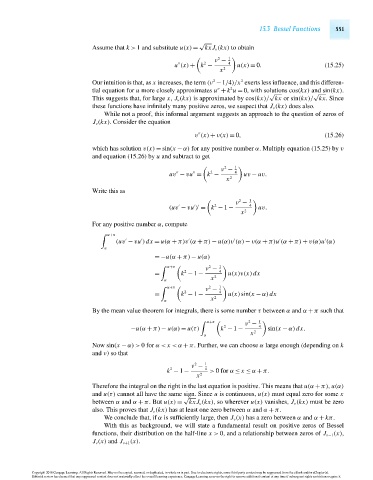Page 571 - Advanced_Engineering_Mathematics o'neil
P. 571
15.3 Bessel Functions 551
√
Assume that k > 1 and substitute u(x) = kx J ν (kx) to obtain
2 1
ν −
2 4
u (x) + k − u(x) = 0. (15.25)
x 2
Our intuition is that, as x increases, the term (ν −1/4)/x exerts less influence, and this differen-
2
2
tial equation for u more closely approximates u + k u = 0, with solutions cos(kx) and sin(kx).
2
√ √
This suggests that, for large x, J ν (kx) is approximated by cos(kx)/ kx or sin(kx)/ kx. Since
these functions have infinitely many positive zeros, we suspect that J ν (kx) does also.
While not a proof, this informal argument suggests an approach to the question of zeros of
J ν (kx). Consider the equation
v (x) + v(x) = 0, (15.26)
which has solution v(x) = sin(x − α) for any positive number α. Multiply equation (15.25) by v
and equation (15.26) by u and subtract to get
2 1
ν −
2 4
uv − vu = k − uv − uv.
x 2
Write this as
2 1
ν −
2 4
(uv − vu ) = k − 1 − uv.
x 2
For any positive number α, compute
α+π
(uv − vu )dx = u(α + π)v (α + π) − u(α)v (α) − v(α + π)u (α + π) + v(α)u (α)
α
=−u(α + π) − u(α)
2
α+π
ν − 1
2 4
= k − 1 − u(x)v(x)dx
x 2
α
2
α+π
ν − 1
2 4
= k − 1 − u(x)sin(x − α)dx
x 2
α
By the mean value theorem for integrals, there is some number τ between α and α + π such that
α+π ν −
2 1
2
−u(α + π) − u(α) = u(τ) k − 1 − 4 sin(x − α)dx.
x 2
α
Now sin(x − α) > 0for α< x <α + π. Further, we can choose α large enough (depending on k
and ν) so that
2 1
ν −
2 4
k − 1 − > 0for α ≤ x ≤ α + π.
x 2
Therefore the integral on the right in the last equation is positive. This means that u(α +π), u(α)
and u(τ) cannot all have the same sign. Since u is continuous, u(x) must equal zero for some x
√
between α and α + π.But u(x) = kx J ν (kx), so wherever u(x) vanishes, J ν (kx) must be zero
also. This proves that J ν (kx) has at least one zero between α and α + π.
We conclude that, if α is sufficiently large, then J ν (x) has a zero between α and α + kπ.
With this as background, we will state a fundamental result on positive zeros of Bessel
functions, their distribution on the half-line x > 0, and a relationship between zeros of J ν−1 (x),
J ν (x) and J ν+1 (x).
Copyright 2010 Cengage Learning. All Rights Reserved. May not be copied, scanned, or duplicated, in whole or in part. Due to electronic rights, some third party content may be suppressed from the eBook and/or eChapter(s).
Editorial review has deemed that any suppressed content does not materially affect the overall learning experience. Cengage Learning reserves the right to remove additional content at any time if subsequent rights restrictions require it.
October 14, 2010 15:20 THM/NEIL Page-551 27410_15_ch15_p505-562

